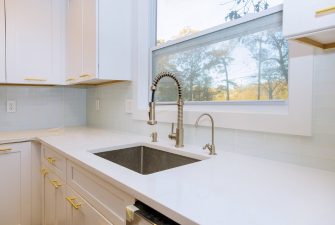When it comes to kitchen design, many terms, such as cabinet or countertop, can be very confusing. This can be even worse if you are not used to kitchen setups or working on your first kitchen build.
So what are the actual differences between kitchen countertops vs cabinets?
Kitchen countertop refers to the surface on top of the counter, where you can mount things such as a sink, cooking hob, etc. Kitchen cabinet refers to the storage spaces under and above the countertop, usually enclosed with a door. Both perform complementary functions to each other in a modern kitchen.
This post discusses kitchen cabinets and countertops. We will also look at how different they are, so you can easily tell and use the term in the future.
What Is a Kitchen Cabinet?
A kitchen cabinet is commonly used to store and organize things like dishes, utensils, and small appliances. Cabinets are usually built into a wall or made to stand independently. Cabinets are often combined with countertops, sinks, ovens, and other things to make a complete kitchen.
A kitchen cabinet is a piece of furniture used to store and organize things like dishes, cooking tools, and small appliances.
Cabinets can be made out of wood, laminate, and metal, among other things. The style of a kitchen cabinet can also vary, ranging from traditional doors with raised panels to sleek, modern styles.
In a kitchen, cabinets are usually built into the walls or can stand independently. Cabinets are often put together with countertops and sinks to make a full workstation in the kitchen. Cabinets also come in many different styles, colors, and finishes, to fit into all kinds of design ideas.
There are three types of kitchen cabinets:
- Base Cabinet: The base cabinet usually sits on the floor and commonly has countertops mounted on top of it.
- Wall Cabinets: These are often mounted to the wall, on top of the countertop and workstation.
- Tall cabinets: also called pantry cabinets, they are usually used to store food and could be as tall as 96 inches (about 243 cm)
You can buy cabinets in standard sizes or custom-made to fit your needs. You can also customize and personalize your cabinetry with pull-out shelves, built-in lighting, soft-closing doors, and drawers.
What Is a Kitchen Countertop?
A kitchen countertop is a flat surface where you can engage in food preparation work such as cooking. Kitchen countertops are usually mounted on top of a base cabinet. They could be made of granite, marble, quartz, wood, laminated plastic, or more.
If cabinets are used to store things, then the countertop places things to work on. It is a table-like surface where you can do things such as cutting or cooking.
Countertops are usually mounted on a base cabinet and may have holes cut into them to fit things such as sinks and hobs. Countertops can also vary in thickness and shape. The most common thickness is 1.5 to 2 inches (about 3.8 – 5.1 cm)
Most of the time, they are put in as one piece, but in larger kitchens with a more organic design, multiple pieces may be put together to make one smooth surface. Countertops are usually made of granite, marble, quartz, wood, laminated plastic, or sheet metal.
Each of these materials has its own upsides and downsides. For example, Wood countertops may look beautiful, but they may not last as long as granite tops. Sheet metal tops may be ultra-durable and affordable, but they may not look nice.
How Does the Height of Countertops Impact the Balance between Countertops and Cabinets in Kitchen Design?
When considering the balance between countertops and cabinets in kitchen design, it is crucial to take into account the proper height for countertops. The height of countertops can greatly impact the overall aesthetics and functionality of the kitchen, as well as the ergonomic comfort of the users.
How Are Kitchen Countertops and Cabinets Different?
The kitchen countertop and cabinet differ in function, materials, accessory options, and size. Together, countertops and cabinets form the major parts of a modern kitchen workspace, and they complement each other.
| Aspects | Kitchen Cabinets | Kitchen Countertops |
|---|---|---|
| Function | To store kitchen appliances, tools, and foodstuff | As a working surface to process and prepare food |
| Materials | Wood, plastic, aluminum, or stainless steel | Granite, marble, quartz, wood, laminated plastic, or sheet metal such as stainless steel |
| Accessory Options | Soft-closing lid, knobs and handles, shelves | Soft-closing lid, knobs, and handles, shelves |
| Space | Takes more space | Takes less space |
Function
A cabinet’s main function is to store things. Cabinets allow you to systematically place your kitchen utensils, appliances, tools, and foodstuff into them, ensuring a clutter-free kitchen space.
A countertop’s main function is to be a working surface. It allows a large, flat surface for you to engage in food processing and preparation. Countertops can also end up becoming a surface to eat, although this is not as common.
Materials
Kitchen cabinets may be wall mounted, which means they are usually made of lighter material with good durability. Common materials include wood, aluminum, sheet metal such as stainless steel, or plastic.
With countertops, durability is a key concern, as they will be regularly used, cleaned, and subject to food spills and scratches. As a result, countertops may be made of heavier and more durable materials such as granite, marble, quartz, wood, concrete, or laminated plastic.
Accessory Options
Cabinets may have more accessorizing options, reflecting on their function of storage. Cabinets could have pull-out drawers built into them and soft-closing drawers, lids, and knobs. Cabinets also may have lighting added for aesthetics and as a visual aid.
Countertops are less accessorized, as they are primarily valued for their clean, flat working surface. Decorations such as plants may be added to the corner, while many countertops also may have holes cut into them to mount a sink or a hob.
Space
Cabinets naturally take up much more space than countertops, as their main function is to store things. Countertops are more of a working surface, which means they may have a large vertical footprint. Still, horizontally, the space used is very little.
Should I prioritize my kitchen countertops or backsplash in my interior design decisions?
When deciding between kitchen countertops vs cabinets, consider your design priorities. A stunning backsplash can add a pop of color and texture, while high-quality countertops provide both style and functionality. Ultimately, both elements play a crucial role in tying together your kitchen’s overall aesthetic.
What Are the Benefits of Balancing Kitchen Countertops and Cabinets with Porcelain Countertops?
Porcelain countertops offer numerous benefits for any kitchen design. Pairing stylish porcelain kitchen countertops with your cabinetry creates a cohesive and balanced look. Their durability and resistance to heat, scratches, and stains make them a practical and beautiful choice for any kitchen design.
Final Thoughts
Kitchen cabinets and countertops are essential components of a modern kitchen. While they serve distinct functions, they work together to create a functional and beautiful space for cooking and entertaining.
Understanding the differences between the two can help you make informed decisions when designing or renovating your kitchen.
Whether you prefer granite or quartz countertops or sleek or traditional cabinets, there are endless options to choose from to create the kitchen of your dreams.

